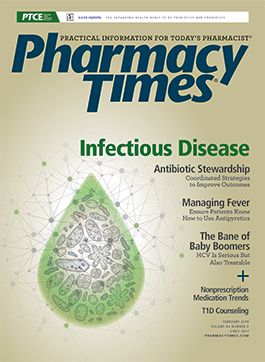Ticagrelor Interactions
Ticagrelor is an orally administered drug that is a direct-acting antagonist of the P2Y12 receptor resulting in reduced platelet aggregation.
Ticagrelor (Brilinta) is an orally administered drug that is a direct-acting antagonist of the P2Y12 receptor resulting in reduced platelet aggregation.1 Ticagrelor differs from clopidogrel and prasugrel in that it is not a prodrug but is extensively metabolized to an active metabolite by CYP3A4. Presystemic metabolism of ticagrelor reduces its bioavailability to about 35%.1 Ticagrelor is also a substrate and inhibitor of P-glycoprotein (P-gp). We recently described the interaction between ticagrelor and cyclosporine that may have involved both CYP3A4 and P-gp inhibition.2 Let’s look at other clinically important interactions with ticagrelor.
Ketoconazole
A single 90-mg dose of ticagrelor was administered to 14 subjects alone or on day 4 of a 10-day course of ketoconazole 200 mg twice a day.3 The coadministration of ketoconazole increased the area under the concentration time curve (AUC) and peak concentration by 7.3-fold and 2.4-fold, respectively. Ticagrelor conversion to its metabolite was reduced. Because of the large magnitude of this interaction, potent inhibitors of CYP3A4 should be avoided in those taking ticagrelor.
Ritonavir
Nineteen healthy subjects received a single 180-mg dose of ticagrelor alone or a single 45-mg dose 2 hours after a single 100-mg dose of ritonavir.4 When 45 mg of ticagrelor was administered after ritonavir, the mean AUC increased 36% and half-life doubled compared with the 180-mg dose administered alone. Plasma concentration of ticagrelor active metabolite was markedly reduced. Platelet inhibition was similar following both doses. The effect of chronic ritonavir dosing on ticagrelor has not been reported. These results would suggest reducing the ticagrelor dose by about 75% if ritonavir is coadministered or avoiding the combination.
Grapefruit Juice
In a randomized study of 10 healthy subjects, a single 90-mg dose of ticagrelor was administered after 4 days of either normal-strength grapefruit juice 3 times a day or with water.5 Compared with water, ingestion of ticagrelor following grapefruit juice resulted in a mean increase of 165% and 221% in peak concentration and AUC, respectively. The half-life of ticagrelor increased from a mean of 6.7 hours to 7.2 hours with grapefruit juice. The peak concentration of the metabolite was reduced, but its AUC was not significantly affected. The antiplatelet effects of ticagrelor were also increased following grapefruit juice pretreatment. Ticagrelor dose reduction should be considered in patients who chronically ingest large amounts of grapefruit juice.
Diltiazem
Administration of a single 90-mg dose of ticagrelor on day 8 of a 14-day course of diltiazem 240 mg daily resulted in a mean increase in ticagrelor AUC by 2.7-fold and peak concentration by 1.7-fold.3 These increases are similar to those described above for grapefruit juice. For both of these precipitant drugs, a 50% reduction (ie, once daily) in the dose of ticagrelor should be considered during their coadministration.
Rifampin
The coadministration of rifampin 600 mg daily for 2 weeks reduced the AUC of ticagrelor by 86% and decreased its peak concentration by 73%.3 It is expected that the administration of rifampin or other CYP3A4 inducers would reduce the antiplatelet efficacy of ticagrelor and should be avoided. This result has been observed during carbamazepine, phenobarbital, and phenytoin coadministration with ticagrelor.6,7
Digoxin
Sixteen subjects received a 0.5-mg dose of digoxin, followed by 0.25 mg daily for 8 days starting on day 6 of placebo ticagrelor or 400 mg ticagrelor daily for 16 days.3 The AUC and trough plasma concentration of digoxin was increased about 30% during ticagrelor dosing. This modest increase in digoxin occurred despite a ticagrelor dose about 4 times the recommended dose.
Conclusion
Ticagrelor should be avoided if possible in patients receiving CYP3A4 inhibitors because of the risk of increased antiplatelet effect and the potential increased risk of bleeding. Other antiplatelet drugs, including clopidogrel or prasugrel, are also substrates for CYP3A4 and would not be ideal substitutes for ticagrelor in these patients. Similarly, the adminis- tration of ticagrelor with CYP3A4 inducers should be avoided. Clopidogrel’s antiplatelet activity is not decreased by CYP3A4 inducers.
John R. Horn, PharmD, FCCP, and Philip D. Hansten, PharmD, are both professors of pharmacy at the University of Washington School of Pharmacy. For an electronic version of this article, including references, visit hanstenandhorn.com.
Reference
- Brilinta [prescribing information]. Wilmington, DE: AstraZeneca Pharmaceuticals LP; 2016. www.accessdata.fda.gov/drugsatfda_docs/label/2016/022433s020lbl.pdf. Accessed January 2, 2018.
- Horn JR, Hansten, PD. Drug interactions where both drugs are affected. Pharm Times. November 2017:28.
- Center for Drug Evaluation and Research. Clinical pharmacology and biopharmaceutics review. www.accessdata.fda.gov/drugsatfda_docs/nda/2011/022433Orig1s000ClinPharm R.pdf. Accessed January 2, 2018.
- Marsousi N, Samer CF, Fontana P, et al. Coadministration of ticagrelor and ritonavir: toward prospective dose adjustment to maintain an optimal platelet inhibition using the PBPK approach. Clin Pharmacol Ther. 2016;100(3):295-304. doi: 10.1002/cpt.407.
- Holmberg MT, Tornio A, Joutsi-Korhonen L, et al. Grapefruit juice markedly increases the plasma concentration and antiplatelet effects of ticagrelor in healthy subjects. Br J Clin Pharmacol. 2013;75(6):1488-1496. doi: 10.1111/bcp.12026.
- Weeks P, Sieg A, Vahdat K, Raissi F, Nathan S. Improved ticagrelor antiplatelet effect on discontinuation of phenytoin. Ann Pharmacother. 2014;48(5):644-647. doi: 10.1177/1060028013520140.
- Pourdjabbar A, Hibbert B, Chong, AY, et al; CAPITAL investigators. A pharmacodynamic analysis for the co-administration of inducers of CYP3A4 with ticagrelor: a cautionary tale in managing patients with acute coronary syndromes. Int J Cardiol. 2016;214:423-425. doi: 10.1016/j.ijcard.2016.03.153.

